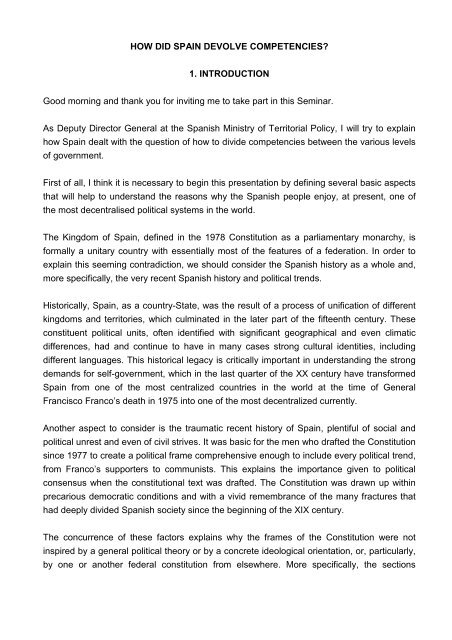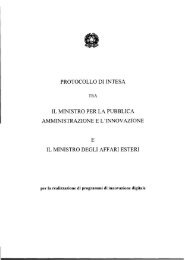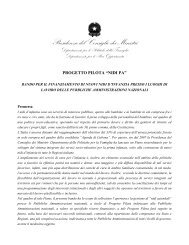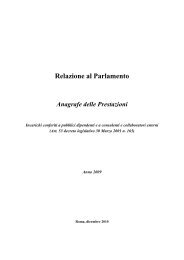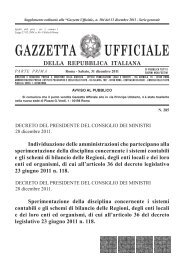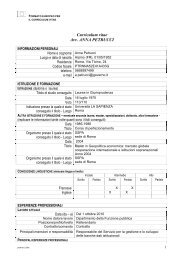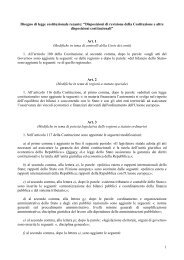HOW DID SPAIN DEVOLVE COMPETENCES? ROME FEBRUARY ...
HOW DID SPAIN DEVOLVE COMPETENCES? ROME FEBRUARY ...
HOW DID SPAIN DEVOLVE COMPETENCES? ROME FEBRUARY ...
Create successful ePaper yourself
Turn your PDF publications into a flip-book with our unique Google optimized e-Paper software.
<strong>HOW</strong> <strong>DID</strong> <strong>SPAIN</strong> <strong>DEVOLVE</strong> COMPETENCIES?<br />
1. INTRODUCTION<br />
Good morning and thank you for inviting me to take part in this Seminar.<br />
As Deputy Director General at the Spanish Ministry of Territorial Policy, I will try to explain<br />
how Spain dealt with the question of how to divide competencies between the various levels<br />
of government.<br />
First of all, I think it is necessary to begin this presentation by defining several basic aspects<br />
that will help to understand the reasons why the Spanish people enjoy, at present, one of<br />
the most decentralised political systems in the world.<br />
The Kingdom of Spain, defined in the 1978 Constitution as a parliamentary monarchy, is<br />
formally a unitary country with essentially most of the features of a federation. In order to<br />
explain this seeming contradiction, we should consider the Spanish history as a whole and,<br />
more specifically, the very recent Spanish history and political trends.<br />
Historically, Spain, as a country-State, was the result of a process of unification of different<br />
kingdoms and territories, which culminated in the later part of the fifteenth century. These<br />
constituent political units, often identified with significant geographical and even climatic<br />
differences, had and continue to have in many cases strong cultural identities, including<br />
different languages. This historical legacy is critically important in understanding the strong<br />
demands for self-government, which in the last quarter of the XX century have transformed<br />
Spain from one of the most centralized countries in the world at the time of General<br />
Francisco Franco’s death in 1975 into one of the most decentralized currently.<br />
Another aspect to consider is the traumatic recent history of Spain, plentiful of social and<br />
political unrest and even of civil strives. It was basic for the men who drafted the Constitution<br />
since 1977 to create a political frame comprehensive enough to include every political trend,<br />
from Franco’s supporters to communists. This explains the importance given to political<br />
consensus when the constitutional text was drafted. The Constitution was drawn up within<br />
precarious democratic conditions and with a vivid remembrance of the many fractures that<br />
had deeply divided Spanish society since the beginning of the XIX century.<br />
The concurrence of these factors explains why the frames of the Constitution were not<br />
inspired by a general political theory or by a concrete ideological orientation, or, particularly,<br />
by one or another federal constitution from elsewhere. More specifically, the sections
devoted to territorial distribution of power were deliberately ambiguous, in order to make<br />
possible agreements among very different parties during the following years.<br />
Thus, the fast pace of reform and adaptation was influenced in many ways by these<br />
historical-political issues, related to the strong cultural identities of some Spanish regions<br />
and, on the other hand, to the purpose of overcome once and for all the rough recent history<br />
of Spain. We should not forget other aspects as, for example, the widespread identification<br />
of centralism with the authoritarian Franco´s regime and, in opposition, the acceptation that<br />
decentralization and democratisation processes were to be linked.<br />
In order to understand how the State devolved competencies to the regions, we have to<br />
consider two aspects. Firstly, we have to take into account the asymmetrical procedures to<br />
accede to self government, determined by historical and political conditions, which justified<br />
that some regions enjoyed of self government faster than the rest. Secondly, the particular<br />
distribution of competencies provided by the Constitution, deliberately ambiguous, that<br />
determined two levels of self government regions: those that obtained the self government<br />
faster were to get a high level of self government from the beginning. Nevertheless, the rest<br />
of regions had to wait five years in order to achieve that same level.<br />
As for PROCEDURES TO BE FOLLOWED TO ACCEDE TO SELF GOVERNMENT.<br />
1. First of all, we have to stress that the Constitution provides a generic self government<br />
principle but does not determine the political units (that is, the regions) that constitute<br />
Spain: it does not establish a territorial “map”, nor does it indicate what responsibilities or<br />
powers can be exercised by these units. This ambiguous phrasing was known, technically,<br />
as “principio dispositivo” (what can be translated as voluntary principle).<br />
2. We should consider also that the devolution process has been asymmetrical. Originally,<br />
and mostly for historical-political reasons, only a small group of regions were devolved<br />
responsibilities at high level. Specifically, and according to the Constitution, there were<br />
several ways to accede to self-government, namely the following:<br />
• On the one hand, the “historical” regions of Catalonia, Galicia and the Basque<br />
Country had an automatic entitlement to autonomy. A rapid procedure was envisaged<br />
for those regions that had sought autonomy in the 1930s, during the II Spanish<br />
Republic. Between 1979 and 1981, their self government basic laws (called statutes)<br />
were passed, after the approval by the Chamber of Deputies (Lower House of the<br />
Parliament), and a previous regional referendum were the proposal for autonomy was<br />
voted.<br />
2
• On the other hand, Constitution provided a slower, “normal” route (based on Section<br />
143) that required a 5 year transitional period during which their autonomy would be<br />
limited. This slow procedure required initiative on the part of municipal and provincial<br />
governments as well as final approval by the Chamber of Deputies, for a degree of<br />
regional autonomy less than that enjoyed by the "historic nationalities."<br />
• A third, “exceptional” route (Section 151) allowed a status equal to that of the historic<br />
regions if a set of stringent conditions were met. Though exceptional, this was the<br />
compromise procedure devised for Andalusia because, although it had not sought<br />
regional autonomy earlier, there was widespread support for such autonomy among<br />
its inhabitants.<br />
Following the relevant agreements of 1981 between the two most representative political<br />
parties in order to make a more systematic devolution process, the regional reorganization<br />
of Spain into self governing regions was completed in 1983, when elections were held in the<br />
thirteen new regions, although the process of transferring powers was far from complete.<br />
At present, all the regions have achieved a similar level of faculties, especially after the<br />
Agreements reached by the two largest political parties in 1992. The difference lies in the<br />
reform procedure of their self governing Statute. The present assignment has evolved over<br />
the years, with the regions taking on responsibility for the provision of a wide range of public<br />
services of a regional nature including most health and education services. The full<br />
devolution of healthcare responsibilities to regional governments took place only in 2002.<br />
3. So, we can see that another interesting aspect of the devolution of responsibilities in<br />
Spain is that it has been gradual. At this point, we should highlight the role of the<br />
Constitutional Court, as supreme interpreter of the Constitution and, more specifically, of the<br />
sections devoted to territorial power distribution.<br />
4. The current organization of government includes, besides the central government, 17<br />
Autonomous Communities (as the regional governments are called) and 2 Autonomous<br />
Cities at the intermediate level, and at the local level, 50 provinces and 8,115 municipalities.<br />
Each regional entity is governed by its own Statute of autonomy. It has its own capital and a<br />
political structure based on a unicameral Legislative Assembly, elected by universal<br />
suffrage. This assembly chooses among its members a president who is the highest<br />
representative of the community. Executive and administrative powers are exercised by the<br />
Council of Government, headed by the president and responsible to the assembly. There<br />
are also regional supreme courts, which are somewhat less autonomous than the legislative<br />
3
and the executive organs because they are subject to the ultimate authority of the Supreme<br />
Court in Madrid.<br />
Since 2006, six regions have launched proceedings to reform their Statutes of Autonomy.<br />
Proposals for reform that have been approved by the regional parliaments must be<br />
submitted to the Spanish parliament which will give the final approval, with modifications<br />
where necessary, by means of an Organic Law, a kind of qualified law. In some regions, it is<br />
also necessary for a reform to be ratified by the citizens through a referendum, as in the<br />
case of Catalonia and Andalusia.<br />
Although most of the reformed Statutes have been appealed to the Constitutional Court, we<br />
can say that we are in a new stage in the self-governing State building process, full of<br />
challenges, as there is a need to reform a relevant number of laws in order to clarify which<br />
powers are subject to transfer. It is necessary to define the powers of both administrations,<br />
once the transfer process of the 80´s nearly fulfilled the Constitutional rules.<br />
At present and very soon, the Constitutional Court will have to declare whether the new<br />
Catalonian self government Statute is constitutional, declaration that will be of vital<br />
importance in order to know the future trend of this new stage in the self-governing State<br />
building process.<br />
Let’s see now a second issue related with the devolution of competencies process, that is,<br />
the DISTRIBUTION OF POWERS BETWEEN STATE AND REGIONS<br />
The distribution of powers between the State and the regions is settled by the Constitution in<br />
the following way:<br />
1. With regard to the State, the Constitution lists its exclusive faculties (Section 149.1).<br />
Among them, foreign policy, defence, customs and foreign trade, and so on. Nevertheless,<br />
this listing is not a homogeneous one, considering that:<br />
• It enlists faculties that belong entirely to the State (Defence).<br />
• In other cases, the State is entitled to regulate the basic aspects of a particular area,<br />
making possible for the regions to intervene in this area (Public Administration).<br />
• It is also possible that the State is entitled to regulate every aspect of a particular area,<br />
corresponding to the regions the administrative performance derived from the State<br />
regulation. (Penitentiary law).<br />
• Finally, the State can also take part in concrete aspects of a regional faculty, when the<br />
exercise of this faculty goes beyond the borders of a region or there exists a general<br />
interest. (Railway or Air traffic).<br />
4
2. With regard to the regions, their faculties could alter depending on the way to accede to<br />
self-government.<br />
Initially, and in relation with the procedures to gain access to self-government we have seen<br />
before, there were two different levels of autonomous powers as some regions were able to<br />
assume all the powers not reserved for the state, while others were restricted to limited<br />
powers regarding those matters mentioned in Section 148.1. In this way, two different levels<br />
of regions were established, not only because of the faster or slower way to obtain self<br />
government, but also considering the asymmetrical number of faculties they could exercise,<br />
initially at last.<br />
The first level of powers was recognised for those regions that were considered “historic” or<br />
acceded to self-government according to the “exceptional” route of Section 151. So, in this<br />
group we include Catalonia, the Basque Country and Galicia, which had held an affirmative<br />
plebiscite on proposed Statutes during the 30´s and were able to accede to the privileged<br />
system right away. Also in this was Andalusia, which had acceded to autonomy through the<br />
Section 151 procedure.<br />
Secondly, the other regions that obtained their self-government according to the “normal”<br />
route could accede to the faculties listed in Section 148.1, that is, a lower level of faculties<br />
compared with the regions that followed the other alternative. Nevertheless, the Constitution<br />
provided that, after five years, these “slow-route” regions would be able to increase their<br />
initial powers, which would be limited only by those reserved exclusively for the State, to<br />
reach the same status as that held by the other regions.<br />
This occurred finally after a delay of some years. Once this process was completed in 1992,<br />
the powers of all the regions were substantially identical, despite the persistence of some<br />
differences.<br />
With regard to the regional faculties, the constitutional provision that sets the powers of the<br />
regions is stated in an even less precise language than in the state case. It declares that<br />
these communities may assume authority over certain areas. These include matters as the<br />
organization of their own institutions of self-government, town planning, housing, forestry,<br />
environmental protection, cultural affairs and organizations, and so on.<br />
As a result of this constitutional ambiguity, the autonomous agreements of 1981 and 1992<br />
have been decisive in order to create an extensive and homogeneous self government<br />
state. Furthermore, the self government statutes are the basic tools in order to know the<br />
5
faculties of the region, provided they operate within the framework and limits imposed by the<br />
Constitution.<br />
3. In addition, the State may delegate to the regions part of its authority in areas reserved to<br />
its jurisdiction. Therefore, although the regions have limited primary authority, the<br />
Constitution permits the extension of this authority by subsequent delegation. These<br />
mechanisms provide the system with flexibility in the distribution of powers both in an<br />
ascending sense (i.e., harmonization laws) and in a descending sense (i.e., laws relating to<br />
the attribution, transfer or delegation of state powers). These instruments are regulated in<br />
Section 150 and have been widely used to match the faculties of the regions (for example,<br />
to allow Canary Islands and Valencia to gain access to a high level of self government<br />
without having to wait five years).<br />
In conclusion, and given the ambiguity of the Constitution, the basic reference for knowing<br />
the regional competencies is the regional Statute.<br />
• There are exclusive faculties, if the region exercises every function (legislative and<br />
executive) over a subject.<br />
• There are also shared competences, which may entail a different distribution of the<br />
legislative and regulatory authority between the State and the regions, which are<br />
usually endowed with detail regulation faculties or executive authority in such<br />
instances.<br />
• There are also concurrent competences in the cases where both State and regions<br />
have faculties and cooperation is needed. For example, in performances related to<br />
culture.<br />
We should not forget the role of the Constitutional Court, as supreme interpreter of the<br />
Constitution and, more specifically, of the constitutional sections devoted to territorial power<br />
distribution.<br />
Once we have seen the complex process of configuration of the present Spanish self-<br />
governing Communities State, I would like to mention different aspects that will help to<br />
understand the daily running of this State, once the Constitution and the regional Statutes<br />
were passed during the 80´s.<br />
6
Namely, we have to refer to the transfer of competences process, the cooperation<br />
instruments and the means that our law provides in order to overcome the conflicts that may<br />
emerge between administrations.<br />
I am afraid I have not enough time, so I will focus in the first mentioned aspect: the transfer<br />
of competences process, as complementary process to the competences assumption<br />
procedures seen before.<br />
2. TRANSFERS OF <strong>COMPETENCES</strong><br />
Inevitably, the distribution of competences between the centre and the regions has proved<br />
to be a complex issue. As we have seen, the Constitution sets down exclusive, shared and<br />
concurrent powers, being the self governing Statute the instrument that sets out the range of<br />
competences the region exercises.<br />
In order to put the regional self government into practice, a transfer of competences<br />
procedure was needed.<br />
According to the Spanish Constitution, as one region asks for a competence that is provided<br />
in its Statute, a process of negotiation begins and a Transfers Mixed Commission is<br />
constituted.<br />
Nevertheless, we have to consider that there are functions which do not require a transfer<br />
process, as the exercise of a concrete faculty does not need personal or financial means or<br />
the region has already the necessary means (expropriate functions).<br />
In other cases, the process of transfer of competences is inspired by the following principles:<br />
• It has to identify which competences are conferred upon the region and which ones upon<br />
the Central Government.<br />
• It has to estimate the funds and human resources necessary to exercise them and<br />
provide the region with them.<br />
• It tries to avoid duplicity. To that end, the transferred resources are exclusively those that<br />
were used by the State before the process of transfer began.<br />
• All this process is based in consensus, that is, the agreement of parties, State and<br />
region. Hence, all this process usually requires a lot of meetings and negotiations.<br />
Once the agreement is reached, this is formally passed by the Mixed Commission,<br />
according to the Constitution.<br />
7
Summing up, the process of transfer comprises the following steps:<br />
1. A region asks for a transfer of a particular competence. It is possible that the Central<br />
Government offers a transfer to a region.<br />
2. A technical committee is called, composed by technical civil servants coming from the<br />
several Ministries than can be affected by the transfer and from the region. Both<br />
parties have to set the specific conditions of the transfer: funds, human resources,<br />
and materials….All this process is called “effective costs valuation”.<br />
a. We can consider the effective costs valuation as the total costs assumed by<br />
the State during the last year: direct and indirect costs, investment funds and<br />
so on.<br />
b. There is a methodology agreed between the State and the regions since 1995.<br />
3. The Mixed Commission formally passes the agreement.<br />
4. This agreement is passed by the Ministries Council by Royal Decree and is published<br />
by the Official Gazette of both, State an region. This agreement will contain:<br />
a. References to the constitutional or statutory laws that support the transfer,<br />
constitutional sentences and any other law.<br />
b. Identification of the competences transferred to the region and the ones that<br />
still remain in the State. In case of shared or concurrent issues, it should clarify<br />
the cooperation mechanisms in order to exercise the competence.<br />
c. Identification of the civil servants that will be transferred, the assets, the rights<br />
and duties.<br />
d. Effective cost valuation and the modifications of the General State Budgets<br />
derived from the transfer.<br />
e. Agreement effective date.<br />
The “Self-governing Agreements” of 1992 were of outstanding significance in order to put all<br />
the regions at the same level in terms of competences. Subsequently, the political<br />
development and the Constitutional Court have contributed to the dynamic evolution of the<br />
Self-governing State:<br />
1. The highest transfers have consisted in education services (170.000 employees<br />
transferred) and health services (140.000 employees transferred). In recent years, the main<br />
transfers have consisted in the transfer of administrative offices of the Courts or nature<br />
reserves.<br />
8
2. On the other hand, six self governing statutes have been reformed since 2006, as we<br />
have seen before. Although most of them have been appealed to the Constitutional Court, a<br />
new transfer process has been implemented.<br />
3. COOPERATION<br />
The distribution of competences between State and self-governing regions means that the<br />
voluntary cooperation of the State and regional administrations is essential in order to carry<br />
out responsibilities effectively for the benefit of citizens.<br />
Currently, there are several ways to put this cooperation into practice, namely:<br />
A) Multilateral cooperation is defined between the State and the regions, in those areas<br />
where their powers are interrelated, in order to achieve objectives which are of mutual<br />
interest to them, to implement policies which are both national and regional, to carry out<br />
projects which are national in scope or which affect the majority of the regions and to<br />
exchange information that is of general interest.<br />
Multilateral cooperation can be carried out through what is known as organic cooperation,<br />
that is, through bodies where both central government and the regions are represented, and<br />
by means of other instruments, such as collaboration agreements and joint action plans and<br />
programmes, through which the central government and regional administrations commit to<br />
carry out actions which are of mutual interest.<br />
The principal cooperation instruments within multilateral cooperation are:<br />
Presidents’ Conference, created in October 2004, must also be highlighted as<br />
representing the main recent progress in multilateral cooperation. It brings together the<br />
president of the government and the presidents of the regions and the cities of Ceuta and<br />
Melilla. It is conceived as a political dialogue body, where the heads of central and regional<br />
governments meet in order to exchange their points of view about the main political trends.<br />
Sectorial Conferences can be defined as multilateral cooperation bodies which operate in<br />
a specific sector of public activity. They comprise the relevant minister and all of the regional<br />
government ministers responsible for the same subject. Due to their composition, number<br />
and activity, they form the main pillar of inter-administrative cooperation.<br />
• It must be taken into account that since the Sectorial Conference is a voluntary<br />
cooperation body, as a general rule, the agreements are only binding on the<br />
signatories. The operation of Sectorial Conferences is governed by its own creation<br />
9
agreement and by its internal regulations, although this is not essential and not all of<br />
them have had them approved.<br />
• There are currently 32 Conferences, although only 25 have engaged in regular<br />
activity in recent years. Their pace of work and the nature and importance of the<br />
subjects they address are not equal. However, it may be stated that the number of<br />
meetings held by these conferences, from 2001 onwards, is usually between 60 and<br />
75 per year.<br />
• Furthermore, it is important to highlight the decision to create new Sectorial<br />
Conferences during the 2004-2008 period, concerning subjects which were required<br />
due to their strategic importance and to their effect on regional powers. Some of the<br />
recently created Conferences are on Local Administration; Science and Technology;<br />
Telecommunications and the Information Society; or University Policy.<br />
• The vast majority of Sectorial Conference agreements contain state financial<br />
commitments or subsidies, so they are used by the government to promote specific<br />
policies and actions that the regions should carry out. The Sectorial Conference<br />
should approve the distribution criteria among regions.<br />
• These state budgetary contributions complement the regions’ contributions and boost<br />
the regional lines of action that the central government wishes to promote.<br />
Agreements in the areas of social policy, infrastructures and environmental policies<br />
stand out due to their importance.<br />
Collaboration Agreements and joint plans and programmes, such as the present<br />
Strategic Infrastructures and Transport Plan (PEIT) (2005-2020) or the Spanish Renewable<br />
Energy Sources Plan (2000-2010), which are usually implemented through collaboration<br />
agreements.<br />
• These agreements, between central government and one or more region, represent,<br />
along with Sectorial Conferences, the most commonly used cooperation instrument in<br />
Spain, due to their characteristic contractual freedom, which makes them particularly<br />
suitable and flexible for formalising the content of the agreements that the State and<br />
regions wish to reach.<br />
• While collaboration agreements should be considered as bilateral cooperation<br />
instruments formally, in practice, many ministries have gradually been promoting the<br />
multilateral treatment of these agreements, using them to propose similar texts to all<br />
or most of the regions.<br />
• As the years have gone by, these agreements have reached stability and continuity,<br />
so a significant number of them have long-term validity, or are renewed on an annual<br />
basis, maintaining an established collaboration.<br />
10
Furthermore, there are State bodies participated by regions. Unlike Sectorial<br />
Conferences, these bodies are central government bodies, created by the government in<br />
order to exercise its powers, in which the autonomous communities can participate because<br />
the central government allows for it.<br />
B) Bilateral cooperation is carried out by the State with a specific region in order to<br />
examine and adopt agreements on subjects which are of particular interest to the State and<br />
that particular region. Bilateral cooperation has been constant for resolving matters affecting<br />
a single region either exclusively or in a particularly significant way. As we have seen<br />
before, the transfer of duties, resources and services which are essential in enabling the<br />
regions to perform their functions, have always taken place via bilateral bodies, such as the<br />
Mixed Transfer Commissions.<br />
The initial Statutes did not consider the existence of Bilateral Cooperation Commissions<br />
(except Navarre), as general collaboration bodies between the state and an region, but the<br />
institutional consolidation of the regions made it necessary to gradually create these bodies,<br />
which started in 1987, by means of agreements between central government and the<br />
autonomous community concerned.<br />
In 1987, Bilateral Cooperation Commissions started to appear. These Commissions are<br />
made up of members of central government and regional government cabinet members and<br />
are created by mutual agreement. Their main function is to prevent competencies conflicts<br />
between the State and a region from being raised before the Constitutional Court.<br />
Most of the recently reformed Statutes of Self-governing, approved in 2006 and 2007,<br />
regulate bilateral cooperation much more extensively, fundamentally through Bilateral<br />
Commissions. The Statutes of Catalonia, Andalusia, Aragon and Castile and León create<br />
new Bilateral Cooperation Commissions as permanent cooperation bodies. Furthermore, the<br />
Statutes of Catalonia, the Balearic Islands, Andalusia and Aragon create other Bilateral<br />
Commissions with powers in financial-tax matters.<br />
The new Bilateral Cooperation Commissions are peer-based, and presided over by the<br />
Minister of Territorial Policy and a minister from the regional government concerned, it being<br />
a rotating presidency. They adopt their agreements by mutual agreement and have<br />
supporting bodies, sub-commissions and working groups.<br />
Collaboration Agreements and joint plans and programmes. Finally, we should consider<br />
as bilateral cooperation tools some of the instruments cited above, as collaboration<br />
agreements with a specific region.<br />
11
4. CONFLICTS<br />
The complexity and ambiguity of the constitutional framework has resulted in frequent<br />
appeals to the Constitutional Court to clarify the respective powers of the State and the<br />
regions. In the period 1981-1989, 749 disputes were filed between State and the regions. In<br />
contrast, during its first 27 years of existence, there were only 43 conflicts filed between the<br />
German central government and the Länder in the German Constitutional Court.<br />
Most of these disputes have been motivated because of the absence of cooperation<br />
mechanisms or the lack of political intention to reach an agreement.<br />
However, there has been a noteworthy moderation in the number of conflicts during the last<br />
years: from 217 disputes in 2000-2004 to only 76 in 2004-2008. Several procedures have<br />
been implemented in order to avoid a high number of disputes. For example:<br />
o Elaboration procedure of law. At the State level, every disposition goes through several<br />
filters, depending on the level of the disposition: reports made by internal units of the<br />
incumbent Ministry, reports made by the Territorial Policy Ministry or made by the State<br />
Council, a legal consultive organ.<br />
o Monitoring Commission of Dispositions and Acts of the region, coordinated by the MPT.<br />
It examines all the legal dispositions passed by the Autonomic Parliaments. There are<br />
several possibilities, if there are problems with the competences distribution:<br />
Propose the conciliation procedure (TC).<br />
Propose to the Ministries Council to lodge an appeal before the TC.<br />
Send a “cooperation letter”.<br />
o Cooperation organs:<br />
Sectorial Conferences, multilateral organs where sectorial rules or procedures are<br />
agreed.<br />
Bilateral Commissions and “Cooperation letters” (when a region knows of a<br />
project that can overrun its competences, sends a letter to the MPT and this one<br />
to the sectorial ministry in order to adapt, if possible, to autonomic demands.<br />
Similarly, these letters are used in the opposite direction, from State to region,<br />
when the project is released in the Official Diary of the autonomic Parliament.<br />
12
o Conciliation procedure introduced in 2000. This procedure searches the extrajudicial<br />
resolution of the conflict before going in the Constitutional Court, extending the deadline<br />
(to nine months) to sue in this Court, provided the plaintiff requested the mentioned<br />
conciliation procedure. During the period 2000-2004, the 66% of the conflicts have been<br />
resolved through this way (49% completely and 17% partially).<br />
5. SELF GOVERNMENT REGIONS FINANCING MODEL<br />
The process of constructing an Autonomous State has involved significant political and<br />
financial decentralisation, due to both the speed at which it has been implemented and its<br />
scope. Starting from a few basic principles that are at the root of self government financing<br />
and are contained in the Constitution, the regional financing model under the common<br />
regime has been shaped in various phases, gradually moving towards what is known as<br />
“joint fiscal responsibility”, instead of financing the regions through a simple share in state<br />
revenue.<br />
First of all, we have to emphasize that the Constitution provides two financing models:<br />
Foral financing system of self government regions. It is only applicable in two regions<br />
(Basque Country and Navarre) as a consequence of the historical rights that Constitution<br />
recognises to these territories.<br />
From a financial point of view, the tax and financial relationships between these territories<br />
and the State will be regulated by Economic Agreement. These regions have the authority to<br />
maintain, establish and regulate their tax systems. These taxes are collected by them and<br />
they contribute to financing the general charges of the state that are not assumed, through<br />
an amount called a “quota” or “contribution”.<br />
The economic quota or contribution is established every five years and is updated annually<br />
by applying an update index to the amount established in the base year. The said index is<br />
the increase of the tax revenue earned by the State in the convention or agreed taxes as<br />
from the base year until the calculation year.<br />
The quota of the Basque Country is deposited at the end of every four-month period. The<br />
Navarra contribution is deposited at the end of every quarter. Both are applied to the State<br />
Income Budget.<br />
Common financing system of self government regions. Recently reformed in December<br />
2009, this financing system has the following fundamental characteristics: COMPLETE<br />
13
6. REGIONAL PARTICIPATION IN EUROPEAN AFFAIRS<br />
The regions have numerous powers which, as a consequence of Spain’s membership of the<br />
European Union, are affected by the decisions of the European institutions. This situation<br />
has given rise to the issue of regional participation in forming state intent before the<br />
European institutions.<br />
As such, since the 90s, cooperation instruments between State and regions have been<br />
created with the aim of defining their participation in the European matters that affect them.<br />
The participation process of regions has gradually been extended since the creation of the<br />
Conference on Issues Related to the European Communities (CARCE), which first met in<br />
1989.<br />
Until 1994, the regions only participated in the application of European community law (in<br />
other words, the “descendent phase”). Since that year, regions began to participate in the<br />
formation of state intent before the European institutions (known as the “ascendant phase”<br />
of the process).<br />
In 1997, the CARCE reached an agreement which established that a region representative,<br />
acting in the name of all of the regions, would join the Spanish delegation, participating in<br />
the committee meetings they attend at the Commission when performing their function of<br />
implementing the actions adopted by the Council.<br />
A new agreement of 2004 granted regions the right to permanently participate in 4<br />
formations of the Council of the European Union, specifically the Council of Ministers of:<br />
Employment, Social Policy, Health and Consumers; Agriculture and Fishing; the<br />
Environment; and Education, Youth and Culture. The system of regional representation is<br />
implemented by incorporating one member in the Spanish delegation who is a minister in a<br />
regional government and who will represent all of the regions in matters affecting their<br />
powers. The plenary session of the Sectorial Conferences affected by the subjects that are<br />
to be addressed, appoints the regional representative, making sure to guarantee both the<br />
stability (each region covering at least six months) and the succession of the representatives<br />
proposed by the various regions.<br />
The appointed regional representative agrees to coordinate with central government, and<br />
commits to make the full documentation on the subject available to the rest of the regions, to<br />
keep them regularly informed about the negotiations, and to agree a common position with<br />
the other affected regions. The regional representative is a full member of the Spanish<br />
delegation in every respect, and can request permission to speak when matters affecting<br />
regional powers are debated and there is a common regional position.<br />
14
Finally, it should be highlighted that the recent reforms of several self government Statutes<br />
has brought about new advances in the relationship between the regions and the institutions<br />
of the European Union. The Statutes list certain regional powers where their powers or<br />
interests are affected, such as:<br />
• Participating in the formation of Spain’s negotiating position before the European<br />
Union.<br />
• Participating in the Spanish delegations before the European institutions and<br />
particularly before the Council of Ministers.<br />
• Presenting appropriate observations and proposals to the state concerning European<br />
initiatives, proposals, projects, rules and decisions, as well as the right to be informed<br />
of such projects.<br />
• Developing and applying the law of the European Union on subjects within their<br />
powers.<br />
15


